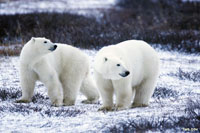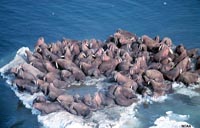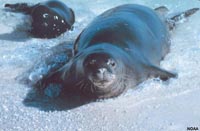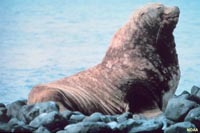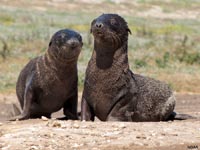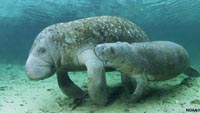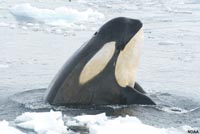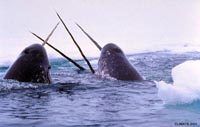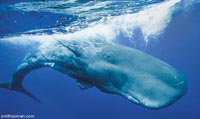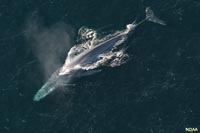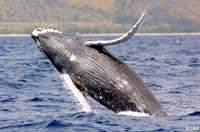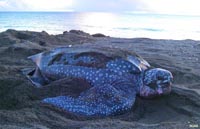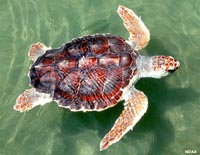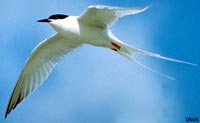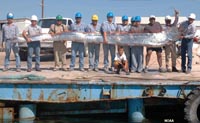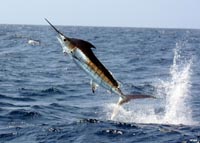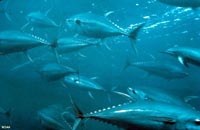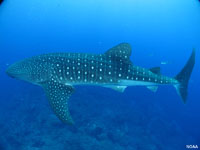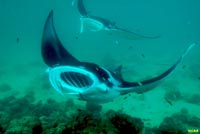
Oceanography 101 |
Return to class home page |
Chapter 16 - Animals in the Pelagic Environment |
This chapter focuses on higher-level organisms in the marine environment, specifically vertebrates, all of which are pelagic animals that can swim (or fly) in the open ocean or coastal marine environments. (The previous Chapter 15 focuses on invertebrates - most of which are either attached or live on or with the seabed (the benthic environment).VertebratesVertebrates are a large group of animals distinguished by the possession of a backbone or spinal column. They belong in the taxa:
|
Click on thumbnail images for a larger view. | ||||||||||||
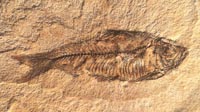 Fig. 16-1. This Wyoming fish fossil displays a well preserved backbone (spinal column). Backbones or spinal columns are common to all vertebrates. Fig. 16-1. This Wyoming fish fossil displays a well preserved backbone (spinal column). Backbones or spinal columns are common to all vertebrates. |
Classes in Vertabrata in the Marine Environment
|
Example of the Taxonomy of Whales
|
||||||||||||||||||||||||||||||||||||||||||||||||||||||||||||||||
Taxonomy of marine vertebrates include:
|
||||||||||||||||||||||||||||||||||||||||
|
|||||||||
|
|||||||||||||||||||||||||||||||||||||||||||||||
Migration of Gray Whales on the West CoastGray whales are probably the most commonly sighted whales in the coastal waters of California. Gray whales have the longest migration of any mammal species, about 10,000 miles 16,000 km) every year.Gray Whales have a routine. They spend the winter months (December to April) in their birthing and mating grounds the shallow bays and lagoons in and around the southern Baja California and southern Gulf of California (Figure 16-23). Gray Whales begin their northward migration in late February to May along the coastline, following the spring blooms of phytoplankton and zooplankton. They are frequently seen moving in small groups (pods) several hundred yards beyond the breaker zones to about 4 kilometers (2.5 miles [4 km]) from shore. Their destination is the rich summer feeding grounds along coastal Alaska and the Bering Sea, a distance of about 5,000-7,000 miles (8,000 to 11,000 km). Adult males and juveniles arrive in northern waters in June; females and young offspring leave and arrive a little later. They spend the summer (June to October) feasting. The first to head south are the pregnant females, followed by the others, some of whom don't make it as far south as Mexico if food resources are available farther north. |
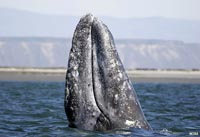 Fig. 15-21. Gray whale 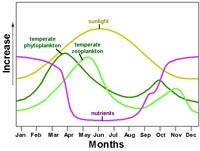 Fig. 15-22. Temperate zone productivity by seasons. |
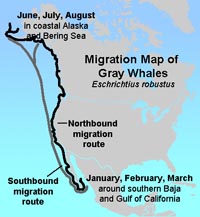 Fig. 16-23. Migration pattern of gray whales along the West Coast of North America. |
Marine ReptilesCompared with the number of reptiles groups and species on Earth, relatively few are adapted to marine environments. The earliest marine reptiles appear in the Permian Period. Many groups emerged in the Mesozoic Era including more familiar varieties including ichthyosaurs, plesiosaurs, and mosasaurs. Many varieties of the Mesozoic Era vanish at the K/T Boundary extinction. |
|
|||||||||||||||
CrocodilesThere are 23 living crocodilian species in both terrestrial aquatic and coastal marine environments. Crocodilians are found in the tropical to subtropical regions on all continents (not Antarctica); they're found in over 90 countries and islands. They are unable to survive and reproduce successfully in cold climates. |
|
 Fig. 16-24. Alligator  Fig. 16-25. Crocodile |
||||||||||||||||||||||
Marine LizardsThe only marine lizard is the Galápagos marine iguana (Amblyrhynchus cristatus)—found only on the Galápagos Islands. This iguana lives along rocky island shorelines and can dive over 9 m (30 ft) into the water to forage for its main diet of red and green algae (Figure 16-27). |
 Fig. 16-26. Galápagos marine iguana |
Extinct Large Marine ReptilesAquatic reptiles first noted from the Permian Period. There were many varieties of large marine reptiles during the Mesozoic Era. All vanished at the end of the Cretaceous Period (about 65 million years ago).Ichthyosaurs: Triassic to Late Cretaceous Plesiosaurs: Early Jurassic - Late Cretaceous Mosasaurs: Late Cretaceous The ancient marine reptiles illustrated convergent evolution - they had terrestrial ancestors like dolphins and whales. |
 Fig. 16-27. A fossil ichthyosaur from Berlin-Itchtyosaur State Park, Nevada |
Sea TurtlesThere are seven species of sea turtles worldwide. Sea turtles sea turtles can be found in all oceans except for the polar regions, along the continents shelves and islands. They are known to nest in more than 80 countries. Sea turtles first appear in the geologic record in early Cretaceous time (land proto-turtles appeared in Permian time). Unlike land turtles, sea turtles are unable to pull their heads or appendages into their shells. Sea turtle shells are lighter and more hydrodynamic than terrestrial turtle shells. There flippers enable them to swim long distances. Male sea turtles spend their entire lives at sea. Females return to the same beaches they were born on about every two years to lay eggs. All adult green sea turtles are herbivores, feeding on algae, sea grasses, and other vegetation. Juvenile are carnivorous, feeding on jellies and other invertebrates. Large adult green sea turtles can weigh upward of 400 pound and over 1 meter. |
Sea SnakesThere are about 50 species. They live in tropical waters of the west Pacific Ocean, around Australia, and in the Indian Ocean. Sea snakes inhabit marine environments for most or all their lives.Sea snakes are generally non aggressive, brightly colored, with small mouth and fangs. Sea snakes have very powerful venom. An average of about 20 deaths per year happen from fishermen trying to remove them from nets. |
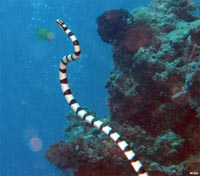 Fig. 16-31. Sea snake. |
Seabirds |
||||||||||||
|
||||||||||||
Fish
|
||||||||||||||||||
|
||||||||||||||||||||||||
Adaptations to the Marine Environment |
• Ability to float (Zooplankton – some produce fats or oils to stay afloat) • Ability to swim (Nekton – larger fish and marine mammals) Propulsion and movement of fish - the body plan of fish reflect adaptations to feeding on prey and fleeing predators. |
| Width/Length Ratio Tuna - .28 Dolphin - .25 Swordfish - .24 Whale - .21 Most efficient is about.25, but there is a size-scale factor. Ratio produced from natural selection “the fittest survive and produce offspring” |
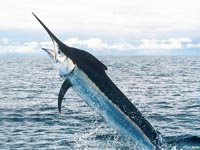 |
| Fig. 16-42. Swordfish |
Compare with Surfboard Design!
|
Kinds of ZooplanktonIncludes organisms described as floaters and drifters. All forms are invertebrates.Microscopic Zooplankton include: Radiolarians, Foraminifers, Copepods Macroscopic Zooplankton: • Krill ( resemble mini shrimp or large copepods, critical in Antarctic food chains) |
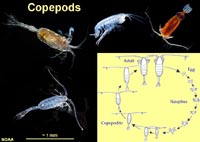 Fig. 16-43. Copepods |
 Fig. 16-44. krill |
| Floating Macroscopic Zooplankton include: • Portuguese man-of-war (have gas-filled float) • Jellyfish (have soft, low-density bodies; there are hundreds of species) Many species of portuguese man-of-war and jellyfish can sting or produce potent toxins. |
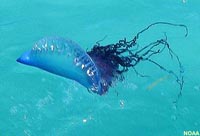 Fig. 16-45. Portuguese man-of-war |
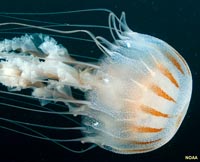 Fig. 16-46. Jellyfish |
| Swimming (Nekton) Organisms Includes all fish, squids, sea turtles and sea snakes, and marine mammals. • Swim by trapping water and expelling it (squid, octopus) • Swim by curving body from front to back (fish, etc.) |
 Fig. 16-47. Squid |
| Adaptations for Finding Prey • Lungers wait for prey and pounce (example: grouper). • Cruisers actively seek prey (example: tuna). They typically hunt in packs. |
 Fig. 16-48. Groupers are lungers |
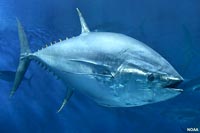 Fig. 16-49. Tuna are cruisers |
| Adaptations to Avoid Predation • Speed • Hiding: includes Transparency, Camouflage and Countershading • Poison (to touch or eat: examples: sea snakes, blowfish, lion fish) • Schooling (safety in numbers, appear as a larger unit, maneuvers confuse predators)
|
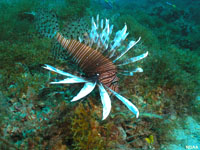 Fig. 16-50. Lionfish are highly poisonous. |
Protecting and Preserving Marine Life: A Most-Essential Goal For the 21st Century |
| The efforts of human exploitation of ocean resources have had catastrophic effects on marine life. The large disasters of modern times have brought attention to some of the problems (i.e. The Alaska-Exxon Valdez oil spill (1989), the destruction of Kuwait's oil fields in the 1st Gulf Wa (1991)r, and the BP Deepwater Horizon Oil Spill in the Gulf of Mexico (2010) are high-profile examples of marine ecosystem disasters (each having long-term impacts). However, it is the small scale, daily exploitation impacts of a growing human population that is having catastrophic effects on marine ecosystems (and human communities that rely on marine resources). * 80% of available fish stock are now fully exploited, overexploited, or depleted/recovering. * Large predatory fish reduced are greatly reduced in populations. * Global warming of ocean waters is causing havoc on marine ecosystems: warmer water increases metabolism needs of marine life, affecting their life and reproduction cycles. In addition, thicker thermoclines reduce upwelling of nutrient-rich waters, reducing primary production. Many countries are now using Fisheries Management. Fisheries management involves regulation, education, enforcement, with an effort to create self-sustaining ecosystems. Much work needs to be done! |
Feeding Frenzies (YouTube videos)Anchovies in Santa Cruz:Sharks along North Carolina beach Sardines, dolphins, birds, sharks, whales Sei whale feeding |
| Chapter 16 quiz questions |


